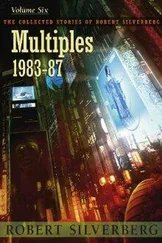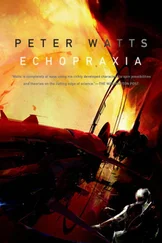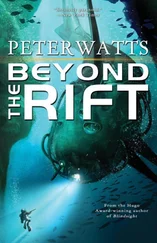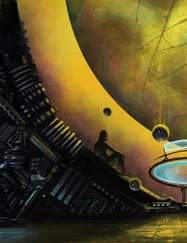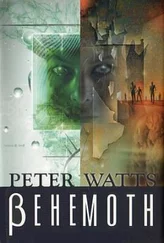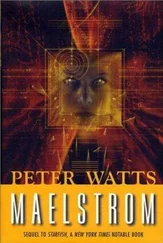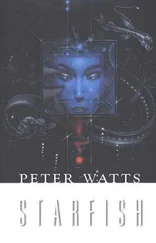The maternal-response opioids that Helen Keeton used to kickstart mother-love in her damaged son was inspired by recent work on attachment-deficit disorders in mice. [129] Moles, A., Keiffer, B.L., and F.R. D’Amato. 2004. Deficit in attachment behavior in mice lacking the m-Opioid receptor gene. Science 304: 1983-1986.
The iron-scavenging clouds that appear in the wake of the Firefall are based on those reported by Plane et al . [130] Plane, J.M.C., et al. 2004. Removal of meteoric iron on polar mesospheric clouds. Science 304: 426-428.
I trawled The Gang of Four’s linguistic jargon from a variety of sources. [81] Hauser, M.D., N. Chomsky, and W.T. Fitch. 2002. The faculty of language: what is it, who has it, and how did it evolve? Science 298: 1569-1579.
, [131] Fitch, W.T., and M.D. Hauser. 2004. Computational Constraints on Syntactic Processing in a Nonhuman Primate. Science 303:377-380.
, [132] Premack, D. 2004. Is Language the Key to Human Intelligence? Science 303: 318-320.
, [133] Holden, C. 2004. The origin of speech. Science 303: 1316-1319.
The multilingual speech patterns of Theseus ’ crew (described but never quoted, thank God) were inspired by the musings of Graddol, [134] Graddol, D. 2004. The future of language. Science 303: 1329-1331.
who suggests that science must remain conversant in multiple grammars because language leads thought, and a single “universal” scientific language would constrain the ways in which we view the world.
The antecedent of Szpindel’s and Cunningham’s extended phenotypes exists today, in the form of one Matthew Nagel. [135] BBC News. 2005. Brain chip reads man’s thoughts. March 31. Story online at http://news.bbc.co.uk/go/pr/fr/-/1/hi/health/4396387.stm .
The spliced prosthetics that allow them to synesthetically perceive output from their lab equipment hails from the remarkable plasticity of the brain’s sensory cortices: you can turn an auditory cortex into a visual one by simply splicing the optic nerve into the auditory pathways (if you do it early enough). [136] Weng, J. et al. 2001. Autonomous Mental Development by Robots and Animals. Science 291: 599-600.
, [137] Von Melchner, L, et al. 2000. Visual behaviour mediated by retinal projections directed to the auditory pathway. Nature 404: 871-876.
Bates’ carboplatinum augments have their roots in the recent development of metal musculature. [138] Baughman, R.H. 2003. Muscles made from metal. Science 300: 268-269.
, [139] Weissmüller, J., et al. 2003. Change-induced reversible strain in a metal. Science 300: 312-315.
Sascha’s ironic denigration of TwenCen psychiatry hails not only from (limited) personal experience, but from a pair of papers [140] Piper, A., and Merskey, H. 2004. The Persistence of Folly: A Critical Examination of Dissociative Identity Disorder. Part I. The Excesses of an Improbable Concept. Can. J. Psychiatry 49: 592-600.
, [141] Piper, A., and Merskey, H. 2004. The Persistence of Folly: A Critical Examination of Dissociative Identity Disorder. Part II. The Defence and Decline of Multiple Personality or Dissociative Identity Disorder. Can. J. Psychiatry 49: 678-683.
that strip away the mystique from cases of so-called multiple personality disorder . (Not that there’s anything wrong with the concept; merely with its diagnosis.) The fibrodysplasia variant that kills Chelsea was based on symptoms described by Kaplan et al .. [142] Kaplan, F.S., et al. 1998. The Molecules of Immobility: Searching for the Skeleton Key. Univ. Pennsylvania Orthopaedic J. 11: 59-66. Available online at http://www.uphs.upenn.edu/ortho/oj/1998/oj11sp98p59.html .
And believe it or not, those screaming faces Sarasti used near the end of the book represent a very real form of statistical analysis: Chernoff Faces, [143] Chernoff, H. 1973. Using faces to represent points in k-dimensional space graphically. Journal of the Americal Statistical Association 68:361-368.
which are more effective than the usual graphs and statistical tables at conveying the essential characteristics of a data set. [144] Wilkinson, L. 1982. An experimental evaluation of multivariate graphical point representations. Human Factors in Computer Systems: Proceedings . Gaithersberg, MD, 202-209.
Creative Commons Licensing Information

Attribution-NonCommercial-ShareAlike 2.5
You are free:
to Share—to copy, distribute, display, and perform the work
to Remix—to make derivative works
Under the following conditions:
Attribution. You must attribute the work in the manner specified by the author or licensor.
Noncommercial. You may not use this work for commercial purposes.
Share Alike. If you alter, transform, or build upon this work, you may distribute the resulting work only under a license identical to this one.
For any reuse or distribution, you must make clear to others the license terms of this work.
Any of these conditions can be waived if you get permission from the copyright holder.
Disclaimer: Your fair use and other rights are in no way affected by the above.
This is a human-readable summary of the Legal Code (the full license):
http://creativecommons.org/licenses/by-nc-sa/2.5/legalcode
License
THE WORK (AS DEFINED BELOW) IS PROVIDED UNDER THE TERMS OF THIS CREATIVE COMMONS PUBLIC LICENSE (“CCPL” OR “LICENSE”). THE WORK IS PROTECTED BY COPYRIGHT AND/OR OTHER APPLICABLE LAW. ANY USE OF THE WORK OTHER THAN AS AUTHORIZED UNDER THIS LICENSE OR COPYRIGHT LAW IS PROHIBITED.
BY EXERCISING ANY RIGHTS TO THE WORK PROVIDED HERE, YOU ACCEPT AND AGREE TO BE BOUND BY THE TERMS OF THIS LICENSE. THE LICENSOR GRANTS YOU THE RIGHTS CONTAINED HERE IN CONSIDERATION OF YOUR ACCEPTANCE OF SUCH TERMS AND CONDITIONS.
1. Definitions
1. “ Collective Work”means a work, such as a periodical issue, anthology or encyclopedia, in which the Work in its entirety in unmodified form, along with a number of other contributions, constituting separate and independent works in themselves, are assembled into a collective whole. A work that constitutes a Collective Work will not be considered a Derivative Work (as defined below) for the purposes of this License.
2. “ Derivative Work”means a work based upon the Work or upon the Work and other pre-existing works, such as a translation, musical arrangement, dramatization, fictionalization, motion picture version, sound recording, art reproduction, abridgment, condensation, or any other form in which the Work may be recast, transformed, or adapted, except that a work that constitutes a Collective Work will not be considered a Derivative Work for the purpose of this License. For the avoidance of doubt, where the Work is a musical composition or sound recording, the synchronization of the Work in timed-relation with a moving image (“synching”) will be considered a Derivative Work for the purpose of this License.
3. “ Licensor”means the individual or entity that offers the Work under the terms of this License.
4. “ Original Author”means the individual or entity who created the Work.
5. “ Work”means the copyrightable work of authorship offered under the terms of this License.
6. “ You”means an individual or entity exercising rights under this License who has not previously violated the terms of this License with respect to the Work, or who has received express permission from the Licensor to exercise rights under this License despite a previous violation.
Читать дальше



